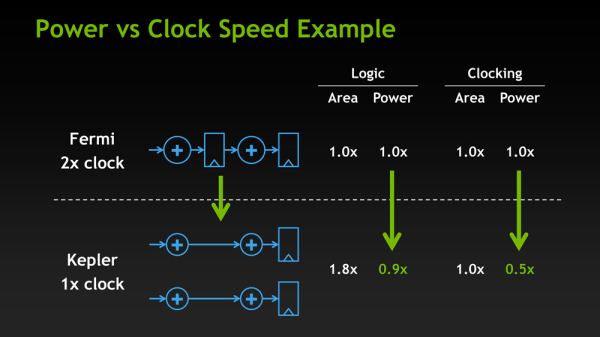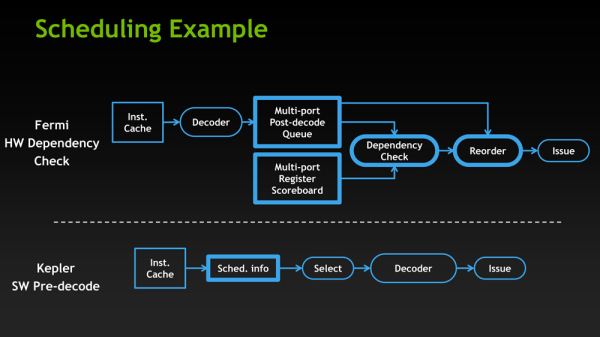NVIDIA GeForce GTX 680 Review: Retaking The Performance Crown
by Ryan Smith on March 22, 2012 9:00 AM ESTThe Kepler Architecture: Efficiency & Scheduling
So far we’ve covered how NVIDIA has improved upon Fermi for; now let’s talk about why.
Mentioned quickly in our introduction, NVIDIA’s big push with Kepler is efficiency. Of course Kepler needs to be faster (it always needs to be faster), but at the same time the market is making a gradual shift towards higher efficiency products. On the desktop side of matters GPUs have more or less reached their limits as far as total power consumption goes, while in the mobile space products such as Ultrabooks demand GPUs that can match the low power consumption and heat dissipation levels these devices were built around. And while strictly speaking NVIDIA’s GPUs haven’t been inefficient, AMD has held an edge on performance per mm2 for quite some time, so there’s clear room for improvement.
In keeping with that ideal, for Kepler NVIDIA has chosen to focus on ways they can improve Fermi’s efficiency. As NVIDIA's VP of GPU Engineering, Jonah Alben puts it, “[we’ve] already built it, now let's build it better.”
There are numerous small changes in Kepler that reflect that goal, but of course the biggest change there was the removal of the shader clock in favor of wider functional units in order to execute a whole warp over a single clock cycle. The rationale for which is actually rather straightforward: a shader clock made sense when clockspeeds were low and die space was at a premium, but now with increasingly small fabrication processes this has flipped. As we have become familiar with in the CPU space over the last decade, higher clockspeeds become increasingly expensive until you reach a point where they’re too expensive – a point where just distributing that clock takes a fair bit of power on its own, not to mention the difficulty and expense of building functional units that will operate at those speeds.
With Kepler the cost of having a shader clock has finally become too much, leading NVIDIA to make the shift to a single clock. By NVIDIA’s own numbers, Kepler’s design shift saves power even if NVIDIA has to operate functional units that are twice as large. 2 Kepler CUDA cores consume 90% of the power of a single Fermi CUDA core, while the reduction in power consumption for the clock itself is far more dramatic, with clock power consumption having been reduced by 50%.
Of course as NVIDIA’s own slide clearly points out, this is a true tradeoff. NVIDIA gains on power efficiency, but they lose on area efficiency as 2 Kepler CUDA cores take up more space than a single Fermi CUDA core even though the individual Kepler CUDA cores are smaller. So how did NVIDIA pay for their new die size penalty?
Obviously 28nm plays a significant part of that, but even then the reduction in feature size from moving to TSMC’s 28nm process is less than 50%; this isn’t enough to pack 1536 CUDA cores into less space than what previously held 384. As it turns out not only did NVIDIA need to work on power efficiency to make Kepler work, but they needed to work on area efficiency. There are a few small design choices that save space, such as using 8 SMXes instead of 16 smaller SMXes, but along with dropping the shader clock NVIDIA made one other change to improve both power and area efficiency: scheduling.
GF114, owing to its heritage as a compute GPU, had a rather complex scheduler. Fermi GPUs not only did basic scheduling in hardware such as register scoreboarding (keeping track of warps waiting on memory accesses and other long latency operations) and choosing the next warp from the pool to execute, but Fermi was also responsible for scheduling instructions within the warps themselves. While hardware scheduling of this nature is not difficult, it is relatively expensive on both a power and area efficiency basis as it requires implementing a complex hardware block to do dependency checking and prevent other types of data hazards. And since GK104 was to have 32 of these complex hardware schedulers, the scheduling system was reevaluated based on area and power efficiency, and eventually stripped down.
The end result is an interesting one, if only because by conventional standards it’s going in reverse. With GK104 NVIDIA is going back to static scheduling. Traditionally, processors have started with static scheduling and then moved to hardware scheduling as both software and hardware complexity has increased. Hardware instruction scheduling allows the processor to schedule instructions in the most efficient manner in real time as conditions permit, as opposed to strictly following the order of the code itself regardless of the code’s efficiency. This in turn improves the performance of the processor.
However based on their own internal research and simulations, in their search for efficiency NVIDIA found that hardware scheduling was consuming a fair bit of power and area for few benefits. In particular, since Kepler’s math pipeline has a fixed latency, hardware scheduling of the instruction inside of a warp was redundant since the compiler already knew the latency of each math instruction it issued. So NVIDIA has replaced Fermi’s complex scheduler with a far simpler scheduler that still uses scoreboarding and other methods for inter-warp scheduling, but moves the scheduling of instructions in a warp into NVIDIA’s compiler. In essence it’s a return to static scheduling.
Ultimately it remains to be seen just what the impact of this move will be. Hardware scheduling makes all the sense in the world for complex compute applications, which is a big reason why Fermi had hardware scheduling in the first place, and for that matter why AMD moved to hardware scheduling with GCN. At the same time however when it comes to graphics workloads even complex shader programs are simple relative to complex compute applications, so it’s not at all clear that this will have a significant impact on graphics performance, and indeed if it did have a significant impact on graphics performance we can’t imagine NVIDIA would go this way.
What is clear at this time though is that NVIDIA is pitching GTX 680 specifically for consumer graphics while downplaying compute, which says a lot right there. Given their call for efficiency and how some of Fermi’s compute capabilities were already stripped for GF114, this does read like an attempt to further strip compute capabilities from their consumer GPUs in order to boost efficiency. Amusingly, whereas AMD seems to have moved closer to Fermi with GCN by adding compute performance, NVIDIA seems to have moved closer to Cayman with Kepler by taking it away.
With that said, in discussing Kepler with NVIDIA’s Jonah Alben, one thing that was made clear is that NVIDIA does consider this the better way to go. They’re pleased with the performance and efficiency they’re getting out of software scheduling, going so far to say that had they known what they know now about software versus hardware scheduling, they would have done Fermi differently. But whether this only applies to consumer GPUs or if it will apply to Big Kepler too remains to be seen.












404 Comments
View All Comments
Hrel - Thursday, March 22, 2012 - link
It is a little weird that Nvidia gave up ground on the compute side, but their architecture is still vastly superior at tesselation. Which is the main point of DirectX11 and the biggest breakthrough in graphics in the past 12 years; maybe longer. AMD has improved that part of their GPU's quite a bit since the HD4000/HD5000 series; but they clearly still have a long way to go.Nvidia wins on every single front; this is why all my graphics cards are Nvidia now. I'm just glad AMD is so competitive, hopefully prices will start falling again, before December.
SydneyBlue120d - Thursday, March 22, 2012 - link
Hope to see some testing about video decoding and encoding, especially 4K compared with AMD cards :) Thanks :)shaggart5446 - Thursday, March 22, 2012 - link
seems like tom is getting paid just like fuddo where on earth could you say gtx680 is better than 7970 nediot pick your games them what to bench mark why did amd win in some test result shouldnt nediot wins all the bench mark if your gonna say gtx680 is fastersilverblue - Thursday, March 22, 2012 - link
No.CeriseCogburn - Thursday, March 22, 2012 - link
Obviously amd has been paying off Crysis and Metro game companies )CeriseCogburn - Thursday, March 22, 2012 - link
But not Crysis 2 game company which we can't benchmark anymore because amd can't play that modern title )edwpang - Thursday, March 22, 2012 - link
It'll be interesting to know the real engine clock these cards are running when testing, since GTX 680 has the "Boost Clock" feature.Ryan Smith - Thursday, March 22, 2012 - link
Unfortunately Precision X doesn't have any logging, so I don't have any precise numbers. However I did take notes from what I saw in Precision X during our testing, which I'm happy to post here (just keep in mind that they're my internal notes).----
Crysis: Generally sustained at 1097; fluctuates some at 2560 between 1071 and 1097 due to power load.
Metro: Frequently bounces between a range of 1045 to 1097.
Dirt 3: Bounces between 1084 and 1097.
Shogun 2: Fluctuates between 1071 and 1019; very high load.
Batman: Some fluctuating between 1097 and 107.
CivV: Mostly 1097; a few drops to 1084.
Portal 2: Between 1058 and 1006.
BF3: 1097 sustained
SC2: 1097 sustained
Skyrim: 1097 sustained
SLG: 1097 sustained
Everyone - Thursday, March 22, 2012 - link
"the GTX 680 is faster, cooler, and quieter than the Radeon HD 7970"Sounds just like the launch of the 5870. But here's the problem. I bought a 5870 over two years ago, in a decent sale which had it priced at $325. Just now, two years later, are we getting cards that beat its performance by a wide margin and make me feel like it's actually time to upgrade. But look at the pricing! The Nvidia 680 is $500. There still isn't a card out there at the price level I paid two years ago (a price level I feel very comfortable with in contrast to the over $500 card market which I view as 'high end out of my wallet range') gives me a decent jump in performance over my 5870.
I read every new videocard review anandtech posts, but I can't shake the feeling that something here is a little weird. In such a rapidly evolving market, why is it that two years later there hasn't been a realistic improvement in the level of graphics cards that I (and many others I'd imagine) am interested in?
prophet001 - Thursday, March 22, 2012 - link
talk to obama